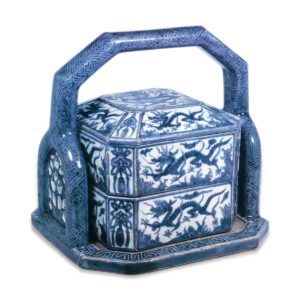
Height 23.8 cm, Bottom diameter 22.1 x 23.0 cm
Tokyo National Museum
Throughout the Edo period, the overwhelming majority of Chinese blue-and-white porcelain that was prized by the sukiya were Nanjing tsusuke (called kosotsuke today), produced in the Tenge period at the end of the Ming dynasty, and Shozui porcelain produced in the Chongzhen period. Therefore, most of the underglaze blue and white porcelain fired in various parts of Japan also followed the ko-zome and shozui styles, and the master potters of Kyo-yaki at the end of the Edo period were no exception. The design of this piece, inscribed on the box with the inscription “Aobase tsutsumi liang yu yu yu with layers of blue flowers, dragon play and waves, by Kikume,” is clearly modeled after Manryaku underglaze blue.
The two-tiered stacked box with four corners cut in four directions was made to fit into a bottom frame with tsutsumi beams, and each side of the box from the lid to the body, except for the four corners, is decorated with dragon and wave patterns. The tsutsuribi is decorated with a gauze pattern on a dark underglaze blue ground, and the bottom frame is decorated with a thunderbolt pattern. The bottom frame is covered with a thunderbolt motif. The bottom back of the lower section is engraved with the inscription “KOKI KANZEI” in a long double-layered frame. It was donated to the Tokyo National Museum by Tatsuko Kasagi.



